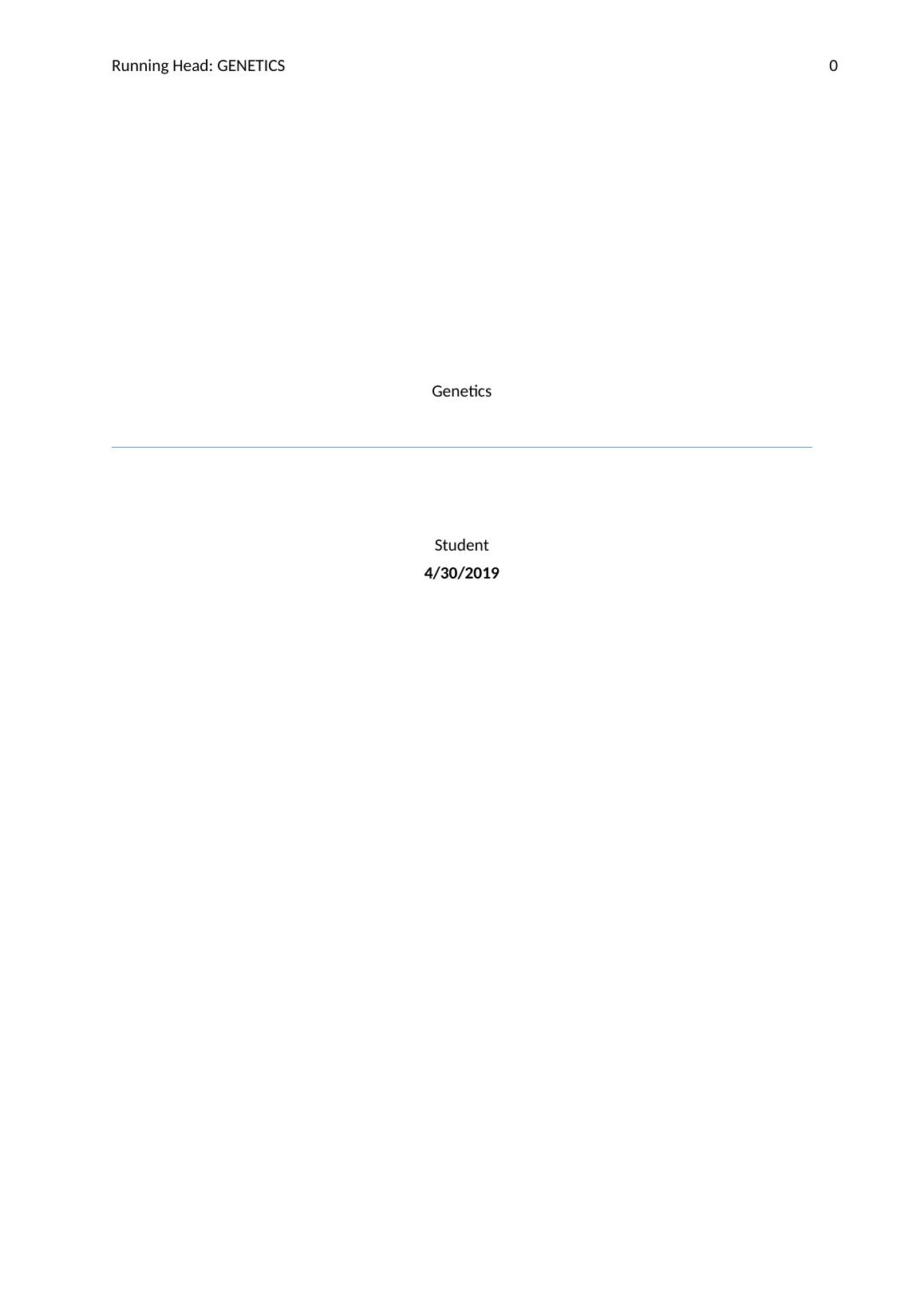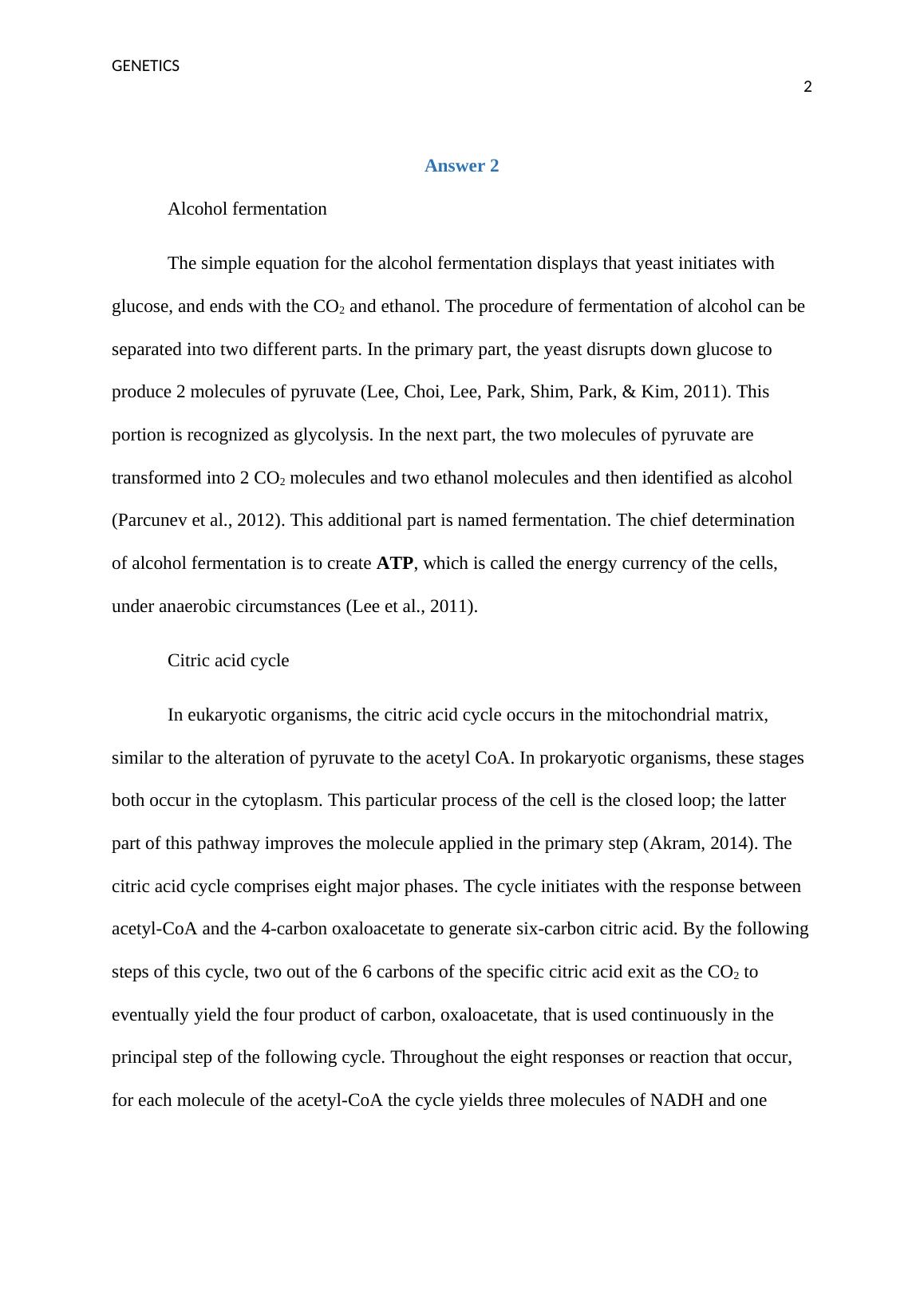Genetics
Added on 2022-12-16
13 Pages2951 Words351 Views
Running Head: GENETICS 0
Genetics
Student
4/30/2019
Genetics
Student
4/30/2019

GENETICS
1
Table of Contents
Answer 2.................................................................................................................. 2
Answer 3.................................................................................................................. 3
Answer 5.................................................................................................................. 4
Answer 7.................................................................................................................. 6
Answer 8.................................................................................................................. 7
Answer 9.................................................................................................................. 8
1
Table of Contents
Answer 2.................................................................................................................. 2
Answer 3.................................................................................................................. 3
Answer 5.................................................................................................................. 4
Answer 7.................................................................................................................. 6
Answer 8.................................................................................................................. 7
Answer 9.................................................................................................................. 8

GENETICS
2
Answer 2
Alcohol fermentation
The simple equation for the alcohol fermentation displays that yeast initiates with
glucose, and ends with the CO2 and ethanol. The procedure of fermentation of alcohol can be
separated into two different parts. In the primary part, the yeast disrupts down glucose to
produce 2 molecules of pyruvate (Lee, Choi, Lee, Park, Shim, Park, & Kim, 2011). This
portion is recognized as glycolysis. In the next part, the two molecules of pyruvate are
transformed into 2 CO2 molecules and two ethanol molecules and then identified as alcohol
(Parcunev et al., 2012). This additional part is named fermentation. The chief determination
of alcohol fermentation is to create ATP, which is called the energy currency of the cells,
under anaerobic circumstances (Lee et al., 2011).
Citric acid cycle
In eukaryotic organisms, the citric acid cycle occurs in the mitochondrial matrix,
similar to the alteration of pyruvate to the acetyl CoA. In prokaryotic organisms, these stages
both occur in the cytoplasm. This particular process of the cell is the closed loop; the latter
part of this pathway improves the molecule applied in the primary step (Akram, 2014). The
citric acid cycle comprises eight major phases. The cycle initiates with the response between
acetyl-CoA and the 4-carbon oxaloacetate to generate six-carbon citric acid. By the following
steps of this cycle, two out of the 6 carbons of the specific citric acid exit as the CO2 to
eventually yield the four product of carbon, oxaloacetate, that is used continuously in the
principal step of the following cycle. Throughout the eight responses or reaction that occur,
for each molecule of the acetyl-CoA the cycle yields three molecules of NADH and one
molecule of flavin adenine dinucleotide (FAD/FADH2), alongside with one particle of ATP
(Max, et al., 2010).
2
Answer 2
Alcohol fermentation
The simple equation for the alcohol fermentation displays that yeast initiates with
glucose, and ends with the CO2 and ethanol. The procedure of fermentation of alcohol can be
separated into two different parts. In the primary part, the yeast disrupts down glucose to
produce 2 molecules of pyruvate (Lee, Choi, Lee, Park, Shim, Park, & Kim, 2011). This
portion is recognized as glycolysis. In the next part, the two molecules of pyruvate are
transformed into 2 CO2 molecules and two ethanol molecules and then identified as alcohol
(Parcunev et al., 2012). This additional part is named fermentation. The chief determination
of alcohol fermentation is to create ATP, which is called the energy currency of the cells,
under anaerobic circumstances (Lee et al., 2011).
Citric acid cycle
In eukaryotic organisms, the citric acid cycle occurs in the mitochondrial matrix,
similar to the alteration of pyruvate to the acetyl CoA. In prokaryotic organisms, these stages
both occur in the cytoplasm. This particular process of the cell is the closed loop; the latter
part of this pathway improves the molecule applied in the primary step (Akram, 2014). The
citric acid cycle comprises eight major phases. The cycle initiates with the response between
acetyl-CoA and the 4-carbon oxaloacetate to generate six-carbon citric acid. By the following
steps of this cycle, two out of the 6 carbons of the specific citric acid exit as the CO2 to
eventually yield the four product of carbon, oxaloacetate, that is used continuously in the
principal step of the following cycle. Throughout the eight responses or reaction that occur,
for each molecule of the acetyl-CoA the cycle yields three molecules of NADH and one
molecule of flavin adenine dinucleotide (FAD/FADH2), alongside with one particle of ATP
(Max, et al., 2010).

GENETICS
3
Electron transport chain
The electron transport chain is the cluster of protein molecules that transfer the
electrons by a membrane to generate an incline of protons that generates ATP (adenosine
triphosphate) or energy that is desired in metabolic procedures for the cellular function
(Durieux, Wolff, & Dillin, 2011). Throughout the course, a gradient of a proton is produced
when the protons are driving from the matrix of mitochondrial into the cellular inter-
membrane space, which likewise assists in driving the ATP creation. Frequently, the usage of
a gradient of the proton is mentioned to as the chemiosmotic process that energies synthesis
of ATP since it depend on an advanced concentration of the protons to produce “proton
motive force”. The quantity of ATP shaped is directly comparative to the number of protons
that are driving across the internal mitochondrial membrane (Lapuente-Brun, et al., 2013).
Answer 3
Components necessary for converting corn to ethanol
Ethanol is an alcohol created by the yeast from sugars. It is the similar alcohol formed
by yeast in beer, wine, and the spirits. Fuel ethanol is the ethanol that has been extremely
concentrated to eliminate water and mixed with other complexes to reduce the alcohol un-
drinkable. Certain of the components necessary to generate ethanol from corn are
carbohydrates, starch, fibre, a simple sugar, protein, oil, minerals and other components
(Uppugundla, et al., 2014). Other components like lignin, cellulose, and hemicellulose are
also necessary. Wood comprises 43 per cent cellulose with the softwood consuming 2-3 per
cent fewer than hardwood, nearly 24-33 per cent lignin and the residual hemicellulose. The
Lignin helps as a kind of glue providing the biomass fibres with its organizational strength;
3
Electron transport chain
The electron transport chain is the cluster of protein molecules that transfer the
electrons by a membrane to generate an incline of protons that generates ATP (adenosine
triphosphate) or energy that is desired in metabolic procedures for the cellular function
(Durieux, Wolff, & Dillin, 2011). Throughout the course, a gradient of a proton is produced
when the protons are driving from the matrix of mitochondrial into the cellular inter-
membrane space, which likewise assists in driving the ATP creation. Frequently, the usage of
a gradient of the proton is mentioned to as the chemiosmotic process that energies synthesis
of ATP since it depend on an advanced concentration of the protons to produce “proton
motive force”. The quantity of ATP shaped is directly comparative to the number of protons
that are driving across the internal mitochondrial membrane (Lapuente-Brun, et al., 2013).
Answer 3
Components necessary for converting corn to ethanol
Ethanol is an alcohol created by the yeast from sugars. It is the similar alcohol formed
by yeast in beer, wine, and the spirits. Fuel ethanol is the ethanol that has been extremely
concentrated to eliminate water and mixed with other complexes to reduce the alcohol un-
drinkable. Certain of the components necessary to generate ethanol from corn are
carbohydrates, starch, fibre, a simple sugar, protein, oil, minerals and other components
(Uppugundla, et al., 2014). Other components like lignin, cellulose, and hemicellulose are
also necessary. Wood comprises 43 per cent cellulose with the softwood consuming 2-3 per
cent fewer than hardwood, nearly 24-33 per cent lignin and the residual hemicellulose. The
Lignin helps as a kind of glue providing the biomass fibres with its organizational strength;

End of preview
Want to access all the pages? Upload your documents or become a member.
Related Documents
Assign. 1: Question 1 Surname, First Name. a).Glucose mlg...
|4
|2931
|28
The glucose molecule is catabolised into waterlg...
|6
|1348
|26
Four Stages of Respiration: Annotated Diagramlg...
|5
|1092
|66
Chemistry and Biochemistry – BIOB111lg...
|11
|1544
|260
Energy Processes in Exercise Sciencelg...
|6
|1048
|235
Biology Practical Questionslg...
|7
|1601
|268
